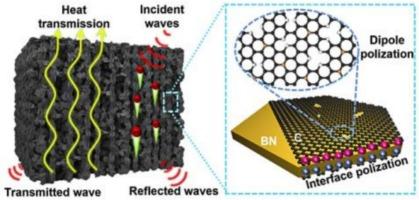具有高效导热和宽带电磁波吸收性能的异质结构碳/氮化硼气凝胶的多尺度结构设计
IF 13.2
1区 工程技术
Q1 ENGINEERING, CHEMICAL
引用次数: 0
摘要
将导热性集成到电磁波吸收(EWA)材料中,为解决下一代电子产品中电磁辐射和热积累问题的双重挑战提供了一个引人注目的解决方案。在这里,我们展示了一种多尺度设计策略,通过构建碳/氮化硼(CBN)气凝胶,在宏观尺度上具有连续的三维(3D)碳框架,在微观尺度上具有BN/C非均相界面。BN/C界面产生了增强的界面极化,使得CBN2粉末/环氧树脂的最小反射损耗(RLmin)为−44.84 dB, EAB为4.8 GHz,通过面导热系数为0.81 W·m−1·K−1。值得注意的是,宏观尺度连续三维碳骨架可以极大地促进微观尺度BN/C非均相界面上电子的迁移和不均匀分布。结果表明,超低填料为7 wt%的CBN4气凝胶/环氧树脂的RLmin为- 30.0 dB, CBN4- a的通面导热系数为0.66,面内导热系数为1.67 W/m·K。进一步制备了CBN4气凝胶/环氧树脂超材料,其EAB宽可达15.67 GHz。因此,这种多尺度设计范式为设计先进电子系统中能够同时进行宽带电磁能量耗散和热管理的双功能材料开辟了新的途径。本文章由计算机程序翻译,如有差异,请以英文原文为准。

Multiscale structural design of heterostructured carbon/boron nitride aerogels for efficient thermal conductivity and broadband electromagnetic wave absorption
The integration of thermal conductivity into electromagnetic wave absorption (EWA) materials presents a compelling solution to address the dual challenges of electromagnetic radiation and heat accumulation issue in next-generation electronics. Here, we demonstrate a multiscale design strategy through architecting carbon/boron nitride (CBN) aerogels with a continuous three-dimension (3D) carbon framework at macroscopic scale and BN/C heterogeneous interfaces at microscopic scale. The BN/C interfaces generates enhanced interfacial polarization, endowing the CBN2 powder/epoxy resin with a minimum reflection loss (RLmin) of −44.84 dB, an EAB of 4.8 GHz, and through-plane thermal conductivity of 0.81 W·m−1·K−1. Remarkably, the macroscopic-scale continuous 3D carbon skeleton can greatly promote the migration and uneven distribution of electrons at the microscopic-scale BN/C heterogeneous interface. As a consequence, the CBN4 aerogel/epoxy resin (with an ultra-low filler of 7 wt%) yields an RLmin of −30.0 dB, and its through-plane and in-plane thermal conductivity of CBN4-A is 0.66 and 1.67 W/m·K, respectively. Furthermore, the CBN4 aerogel/epoxy resin metamaterial is further fabricated and its EAB can be as wide as 15.67 GHz. Therefore, this multiscale design paradigm establishes a new route for designing dual-functional material capable of simultaneous broadband electromagnetic energy dissipation and thermal management in advanced electronic systems.
求助全文
通过发布文献求助,成功后即可免费获取论文全文。
去求助
来源期刊

Chemical Engineering Journal
工程技术-工程:化工
CiteScore
21.70
自引率
9.30%
发文量
6781
审稿时长
2.4 months
期刊介绍:
The Chemical Engineering Journal is an international research journal that invites contributions of original and novel fundamental research. It aims to provide an international platform for presenting original fundamental research, interpretative reviews, and discussions on new developments in chemical engineering. The journal welcomes papers that describe novel theory and its practical application, as well as those that demonstrate the transfer of techniques from other disciplines. It also welcomes reports on carefully conducted experimental work that is soundly interpreted. The main focus of the journal is on original and rigorous research results that have broad significance. The Catalysis section within the Chemical Engineering Journal focuses specifically on Experimental and Theoretical studies in the fields of heterogeneous catalysis, molecular catalysis, and biocatalysis. These studies have industrial impact on various sectors such as chemicals, energy, materials, foods, healthcare, and environmental protection.
 求助内容:
求助内容: 应助结果提醒方式:
应助结果提醒方式:


